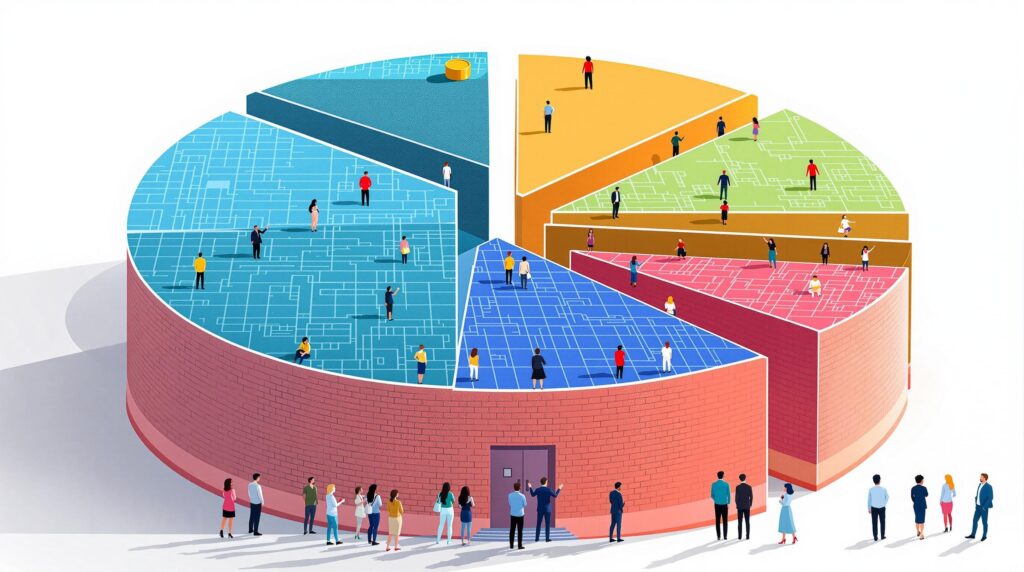[rev_slider alias=”slider-1″][/rev_slider]
Introduction to Layer 1 and Layer 2 Blockchain Solutions
Blockchain technology is truly reshaping the way we think about finance, security, and speed in digital transactions. However, it’s not without its challenges. Two critical components in navigating these challenges are Layer 1 and Layer 2 blockchain solutions. But what exactly do these layers mean, and why are they important?
What are Layer 1 and Layer 2 blockchain solutions? Layer 1 refers to a base level blockchain architecture, like Bitcoin or Ethereum, while Layer 2 builds atop this base to enhance scalability and efficiency.
First, let’s delve into what Layer 1 entails. Essentially, Layer 1 represents the base protocol of a blockchain, which includes the main network of cryptocurrencies like Bitcoin or Ethereum. These networks provide the foundational architecture for verifying transactions and maintaining the blockchain’s security. However, despite their strengths in providing a decentralized and secure ledger, they face certain constraints, particularly with scalability.
Imagine Layer 1 as a busy highway with a fixed number of lanes. When traffic increases, congestion becomes an unavoidable issue, slowing down transaction speeds. That’s where Layer 2 comes into play. It acts like an efficient off-ramp that reduces congestion on the main highway by allowing some traffic to be managed separately.
Layer 2 solutions are protocols that run on top of a layer 1 blockchain, improving its performance without altering the original blockchain architecture. Think of Layer 2 as an upgrade, enhancing the user’s experience by addressing issues such as transaction speed and cost. They utilize techniques like state channels, sidechains, and rollups to manage transactions efficiently.
Why are Layer 2 solutions critical? Layer 2 solutions enable higher throughput by conducting transactions off the main chain, reducing load and preserving security through the base chain.
The key benefits of Layer 2 solutions include:
- Scalability: They support a higher number of transactions per second without overburdening the main blockchain.
- Reduced Costs: Transaction fees are minimized since operations are conducted off-chain.
- Improved Speed: Transactions are processed faster as congestion on the main chain diminishes.
- Enhanced Privacy: With transactions happening off-chain, there is less visibility, which can be advantageous for certain use cases.
The ongoing digital revolution in Africa, driven by companies like Jara, highlights the importance of Layer 2 blockchain solutions. Africa’s digital economy is rapidly expanding, and efficient blockchain solutions are vital for supporting this growth. Jara’s proprietary Layer 2 blockchain is essential in transforming how digital transactions occur in markets with emerging technological infrastructure.
Invest in $JARA today to become an integral part of Africa’s transformative journey. As the demand for digital assets continues to surge, so too does the need for scalable and efficient blockchain technology.
Layer 1 and Layer 2 blockchain solutions are not just technological advancements; they are pivotal in shaping the future of digital finance. They offer solutions to prevailing issues, ensuring blockchain technology remains viable as global transaction demands increase. As we observe this transformative era, there is no doubt that these solutions will continue to play a substantial role in how we structure digital economies worldwide.
Understanding the Functions of Layer 1 Blockchain
Layer 1 blockchain solutions form the foundation of blockchain networks. They are critical in ensuring the security, decentralization, and overall operation of blockchain systems. To grasp how layer 1 functions, it’s important to understand some core elements, especially the consensus mechanisms it employs.
Consensus Mechanisms in Layer 1
Have you ever wondered what keeps a blockchain secure and trustworthy? The consensus mechanism is a vital component for achieving this. It dictates how transactions are validated and how new blocks are added to the blockchain, which is crucial for maintaining its integrity and security.
What is a consensus mechanism? A consensus mechanism in blockchain technology is a process used to achieve agreement on a single data value or a single state of the network among distributed processes or systems.
There are several types of consensus mechanisms, each with its unique approach to managing and securing the blockchain network.
- Proof of Work (PoW): This is the most well-known consensus mechanism, popularized by Bitcoin. It requires miners to solve complex mathematical puzzles to validate transactions and add them to the blockchain, ensuring high security but at a significant computational cost.
- Proof of Stake (PoS): Unlike PoW, PoS selects validators based on the number of coins they hold and are willing to “stake” as collateral. This method reduces energy consumption and allows for faster transaction processing compared to PoW.
- Delegated Proof of Stake (DPoS): In DPoS, stakeholders vote for a small group of delegates to validate transactions and secure the network. This system improves transaction speed and efficiency.
Each consensus mechanism carries its own advantages and challenges, impacting the scalability, decentralization, and security of the blockchain. Understanding how these mechanisms work helps developers choose the right one for their network needs.
Scalability Factors in Layer 1
Layer 1 blockchains often face scalability issues due to their design. Imagine trying to fit more cars onto a single-lane highway — it gets crowded and slows down traffic! Similarly, when more transactions occur on a blockchain, it can lead to slower processing times and higher costs.
Why is scalability important? Scalability in blockchains refers to the capability of the system to handle a growing amount of work or its potential to accommodate growth.
Several strategies aim to enhance the scalability of layer 1 networks:
- Increasing Block Size: By enlarging the block size, more transactions can be processed per block, improving throughput but potentially affecting decentralization.
- Sharding: This involves breaking the blockchain into smaller, more manageable pieces, or “shards,” that can process transactions simultaneously, enhancing efficiency without sacrificing security.
- Layer 1 Improvements: Innovations such as Segregated Witness (SegWit) optimize the handling of transactions by changing how data is stored, reducing the size of each transaction and allowing the system to process more in the same time frame.
By addressing these scalability issues, Layer 1 blockchains can improve their capacity to handle more users and higher transaction volumes, paving the way for widespread adoption.
Role of Security in Layer 1
Security is at the heart of layer 1 blockchains. Much like a safe that protects valuable items, a blockchain’s security mechanisms guard its transaction data against fraud and unauthorized changes.
What ensures security in blockchains? Security in blockchains is maintained through cryptographic techniques that safeguard data and verify transactions, ensuring trustworthiness in a decentralized network.
Key security measures include:
- Cryptographic Hashing: Secure, unique hashes ensure that transaction details cannot be tampered with once recorded on the blockchain.
- Decentralization: By distributing control across multiple nodes, blockchains prevent any single point of failure, making it difficult for malicious entities to alter the network.
- Node Consensus: The collective agreement of nodes regarding the state of the blockchain ensures its integrity and reliability against potential fraud.
These security measures ensure the blockchain remains a reliable and trusted system, which is crucial for its success in replacing traditional centralized systems.
[rev_slider alias=”text-call-cta”][/rev_slider]
The Role and Benefits of Layer 2 Blockchain Solutions
Layer 2 blockchain solutions are revolutionizing the way we interact with decentralized networks by enhancing transaction speed and significantly reducing costs. But what exactly are these solutions, and why are they important? In a nutshell, Layer 2 solutions operate on top of Layer 1 blockchains like Bitcoin and Ethereum to process transactions off the main chain, ensuring both efficiency and scalability without compromising the security of the underlying blockchain.
What are Layer 2 blockchain solutions? Layer 2 solutions are technologies built on top of existing blockchains to improve their transaction capacity and lower costs, making them essential for widespread blockchain adoption.
Enhancing Transaction Speed and Reducing Costs
One of the biggest challenges facing blockchain technology is the scalability issue, which refers to a blockchain’s ability to handle an increasing number of transactions. As networks grow, so does the need for a system that can manage this expansion without delays or increased transaction fees. Layer 2 solutions tackle this problem effectively. By moving transactions off the main blockchain (Layer 1) and processing them separately, they can significantly increase transaction throughput.
- Lightning Network: This is specially designed for Bitcoin and enables fast transactions between participating nodes without the need to directly interact with the blockchain every time.
- Plasma Framework: A solution for Ethereum, Plasma chains are smaller, more manageable blockchains that handle transactions separately to reduce the burden on the Ethereum main chain.
These technologies are vital not just for Bitcoin and Ethereum users but for any application looking to operate more efficiently on blockchain platforms.
Driving Broader Blockchain Adoption
Improving transactional efficiency isn’t just about speeding up processes; it’s also about creating a more accessible and affordable ecosystem for users. Lower transaction costs mean that more individuals and businesses can participate without the prohibitive fees that might otherwise deter them. This factor is crucial in places like Africa, where Jara is focusing its efforts.
Did you know that by 2030, Africa’s digital economy could generate six times more economic activity through blockchain technology and Layer 2 solutions?
With Jara’s proprietary Layer 2 blockchain as a pivotal element of its ecosystem, the goal is to enable Africans to access digital financial services more easily. This mirrors the broader objectives of Layer 2 solutions globally: to democratize financial opportunities by making blockchain technology practical for daily use.
Jara’s Role in Africa’s Financial Evolution
Jara’s ambitious project aims to fuel Africa’s burgeoning digital asset economy through comprehensive Layer 2 blockchain solutions. By offering tools that bridge the digital divide, Jara is setting the stage for transformational financial inclusion.
- Tokenized Real World Assets (RWAs): Jara provides access to invest in tokenized infrastructure projects, such as their flagship $6 billion Lagos airport initiative, making previously inaccessible opportunities available.
- Social Integrated Wallets: These wallets enable users to manage their assets in a user-friendly environment, fostering a sense of community and seamless integration.
This social-first approach, designed for the ‘WhatsApp generation,’ combined with a robust system architecture, makes Jara a key player in the digital transformation happening across Africa.
Ensuring Security and Innovation
Security remains a paramount concern with any blockchain application, and Layer 2 solutions have not diluted this crucial element. By maintaining security protocols while shifting transactions off-chain, these solutions ensure that user data remains protected. Furthermore, the innovation brought about by these technologies does not end at scalability and cost reduction; it extends to how they empower communities like those engaging with Jara’s ecosystem, fostering sustainable economic growth.
Layer 2 solutions are not just a technical upgrade; they’re a pivotal component of driving the digital evolution globally and especially within emerging markets. As with Africa, more regions are likely to benefit from decentralized technology that is truly accessible and tailored to their unique needs.
Comparing Layer 1 vs Layer 2 in Blockchain Ecosystems
Understanding the differences between Layer 1 and Layer 2 blockchain solutions is crucial as they serve distinct but complementary roles within blockchain ecosystems. While Layer 1 solutions refer to the base layer of blockchain protocols, responsible for the fundamental aspects of network security and consensus mechanisms, Layer 2 solutions are designed to build upon these foundations by enhancing scalability and reducing transaction costs.
Layer 1 solutions form the backbone of blockchain technology, addressing security and decentralization, whereas Layer 2 solutions focus on improving speed and scalability.
Scalability Solutions and Future Trends
The blockchain industry continues to face challenges in addressing scalability concerns, which often cause issues like network congestion and high transaction fees. Layer 1 blockchain solutions are limited by their architecture, leading to slower transaction speeds as more users join a network. In contrast, Layer 2 solutions are adept at handling these challenges by creating off-chain processes or secondary protocols that still rely on the security of the underlying Layer 1.
- Layer 1 Scalability Issues: These include high latency and lower throughput due to the consensus mechanisms that ensure security.
- Layer 2 Scalability Solutions: Techniques such as state channels, sidechains, and payment channels effectively alleviate congestion on the main chain.
- Future Trends: The development of Rollups, Plasma, and increased interoperability among different blockchain networks hold promise for further improvements in scalability.
One notable trend in the evolution of blockchain is the adoption of Rollups, which compress transactions off-chain while maintaining a high level of security by settling on the main chain periodically. This innovation supports the promise of faster, more cost-effective blockchain applications in areas ranging from decentralized finance (DeFi) to asset tokenization projects like those spearheaded by Jara in Africa.
What are Rollups in blockchain technology? Rollups are a Layer 2 scaling solution that processes transactions outside the main blockchain and then periodically posts summaries or “rolls up” transactions on the main chain for security.
As blockchain technology continues to mature, the synergy between Layer 1 and Layer 2 solutions becomes crucial for expanding the capabilities and reach of blockchain ecosystems. This collaboration supports not only efficiency and security but also the potential for broader adoption across various sectors and geographies, particularly in emerging markets like Africa where Jara is making significant strides with its proprietary Layer 2 blockchain.
By incorporating strategic partnerships and leveraging advanced blockchain architecture, organizations like Jara are positioned to navigate and lead within the evolving landscape of blockchain solutions, offering innovative prospects for investments and infrastructure developments in Africa’s burgeoning digital economy.
[rev_slider alias=”schedule-consultation-btn”][/rev_slider]

What are Layer 2 blockchain solutions?
Layer 2 blockchain solutions refer to protocols built on top of existing blockchains like Ethereum or Bitcoin, aiming to improve scalability and transaction speeds. They help reduce network congestion and transaction fees by handling transactions off-chain.
Layer 2 solutions enhance the efficiency of blockchain networks by processing transactions off-chain, thus alleviating the main chain’s load.
How do Layer 1 and Layer 2 blockchain solutions differ?
Layer 1 solutions are the foundational protocols of a blockchain network, focusing on security and decentralization. In contrast, Layer 2 solutions are built atop these protocols to enhance scalability and processing speed, making blockchain applications more user-friendly.
- Layer 1: Provides security and decentralization.
- Layer 2: Enhances transaction speed and scalability.
Why is Layer 2 important for blockchain technology?
Layer 2 solutions are essential for blockchain technology as they address scalability challenges, enabling faster and cheaper transactions without compromising the Layer 1’s security. This is pivotal for mass blockchain adoption and use in everyday applications.
The significance of Layer 2 lies in its ability to increase blockchain transaction capacity while keeping fees low, thus broadening blockchain technology’s usability.
Can Layer 2 blockchain solutions affect blockchain security?
While Layer 2 solutions offload transactions from the main blockchain, they maintain security by leveraging the robust security measures of the underlying Layer 1 protocols. However, it’s crucial to implement additional security measures to protect Layer 2 against potential vulnerabilities specific to its framework.
- Utilizes Layer 1 Security: Relies on the inherent security of the main blockchain.
- Additional Measures: Requires separate protocols to safeguard its environment.

Additional Practice Areas We Serve
At Jara, we offer a diverse range of services to meet our clients’ varied legal needs. Explore related practice areas to understand how our expertise in blockchain solutions can assist you further.
List of Top-Rated Layer 1 and Layer 2 Blockchain Solutions Attorneys Serving Jara
Choosing the appropriate legal representation is crucial when pursuing a claim. A seasoned, committed Layer 1 and Layer 2 blockchain solutions attorney ensures you’re equipped to make informed choices at each phase of the process.
John Doe
Jane Smith
Alex Johnson
Hear From Our Satisfied Clients
At the forefront of our Layer 1 and Layer 2 blockchain solutions practice is a deep-seated commitment to client satisfaction. Each case is handled with utmost care, as echoed in the appreciative feedback from those we represent.

[rev_slider alias=”slider-3″][/rev_slider]
[rev_slider alias=”slider-6″][/rev_slider]
Experience Our Expertise in Layer 2 Blockchain Solutions
Blockchain technology is evolving at a rapid pace, and mastering Layer 2 solutions is crucial for staying ahead. Whether you’re looking to enhance transaction speeds or reduce costs, our expertise in Layer 1 and Layer 2 blockchain solutions is unrivaled. Ready to take your blockchain project to the next level?
“Your innovation deserves a foundation of efficiency and scalability.”
Want to see the difference we can make? Get in touch with Jara today at [email protected] or call us at 000-000-0000 for more insights.
Awards and Recognitions
- Award Name: Recognized among the “Top Blockchain Law Firms 2023” by Blockchain Insider.
- Award Name: Named one of the “Best Legal Advisors for Layer 2 Solutions” 2023 by Tech Law Daily.
- Award Name: Highlighted among the “Leading Blockchain Innovators” 2023 by Future Finance Authority.
- Award Name: Listed in the “Top 10 Blockchain Technologists 2023” by Crypto Innovation Awards.
- Award Name: Included in the “Prominent Blockchain Advisors of the Year” 2023 by Digital Law Journal.
Our achievements stand as a testament to our commitment and expertise in driving blockchain innovation and excellence. Explore how these accolades can benefit your specific needs by visiting our website for more information.
Chinyere “Chi” Nnadi Bio
Founder and CEO, Jara | Blockchain Technology Specialist
Content Reviewed by Chi Nnadi and his Content Team. Chi is an experienced entrepreneur dedicated to transforming Africa’s financial ecosystem through blockchain technology. As Founder and CEO of Jara, he builds enterprise-grade infrastructure converting illiquid African assets into globally accessible digital tokens. With his proprietary Layer-2 blockchain solutions, Chi bridges the gap between global investors and Africa’s growing digital asset market.
Our Content Review Process
Chi Nnadi along with Jara’s dedicated content team, pledge to offer top-notch material. Our content guidelines ensure thoroughness, reputable sources, unbiased scrutiny, among other quality metrics. Please let us know if there is anything you believe to be inaccurate.
















